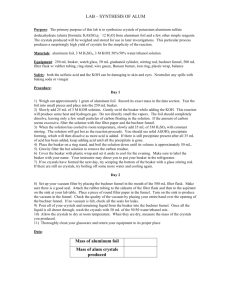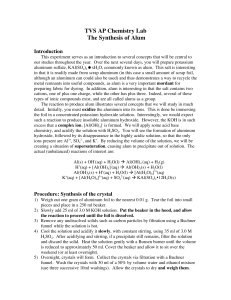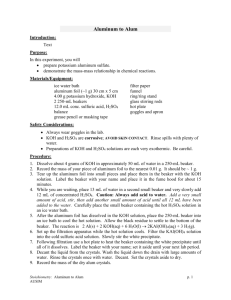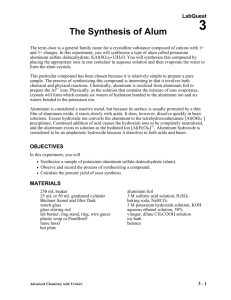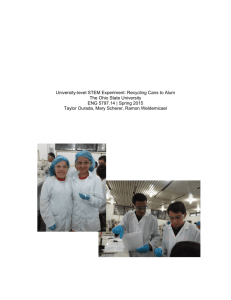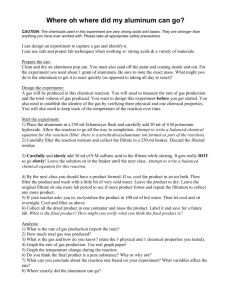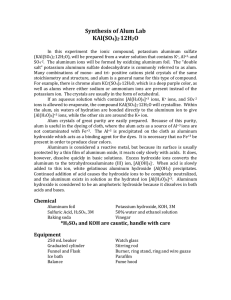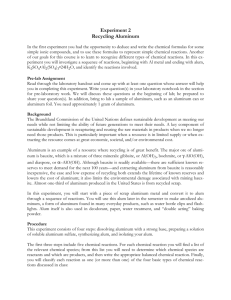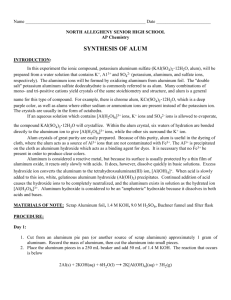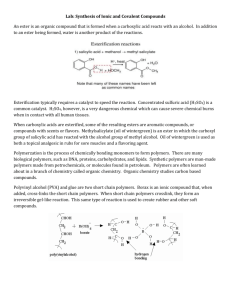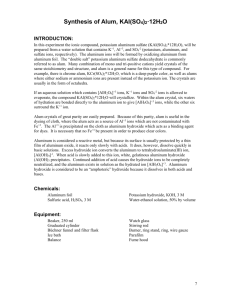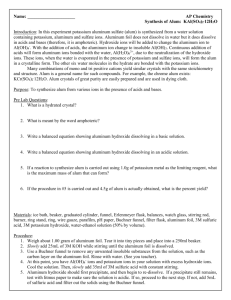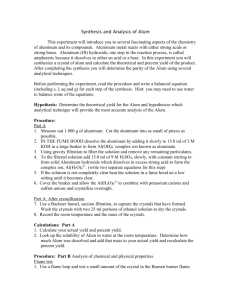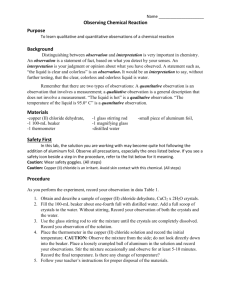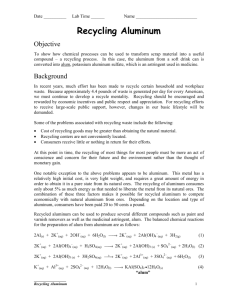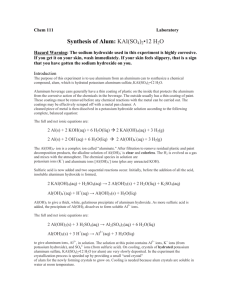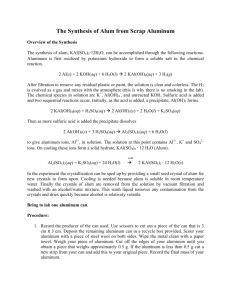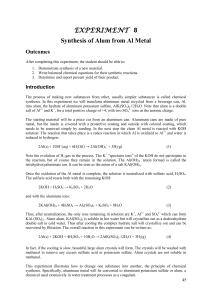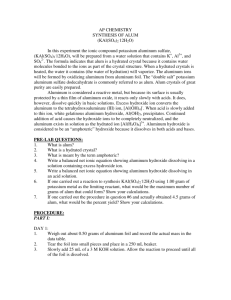Purpose: The primary purpose of this lab is to synthesize crystals of
advertisement
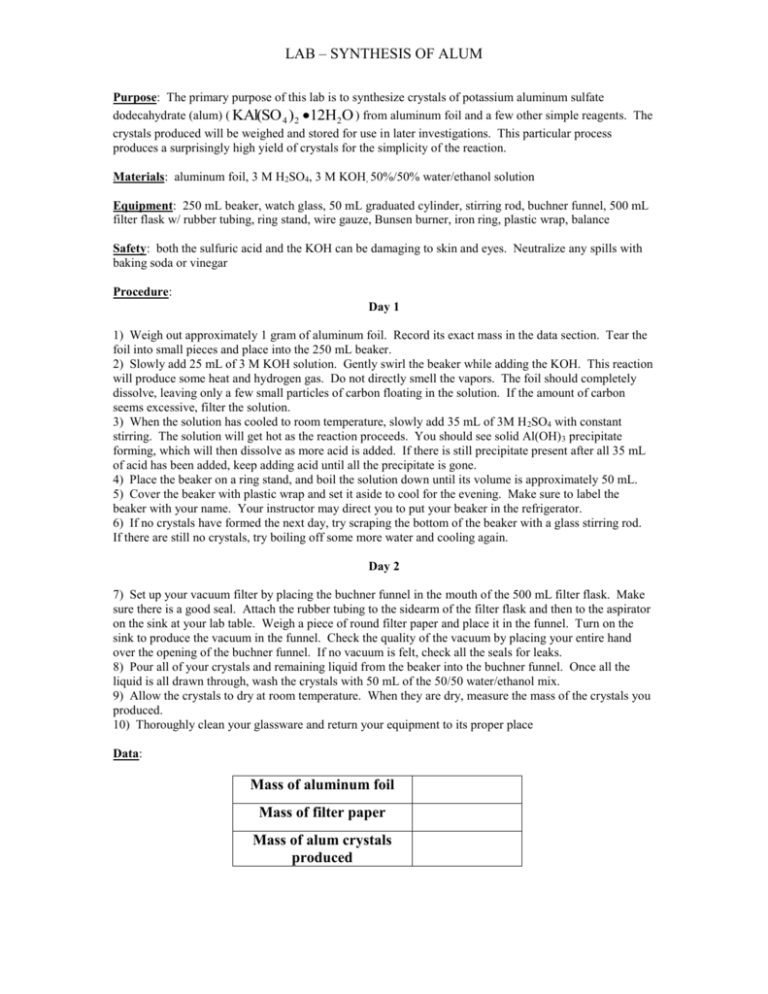
LAB – SYNTHESIS OF ALUM Purpose: The primary purpose of this lab is to synthesize crystals of potassium aluminum sulfate dodecahydrate (alum) ( KAl(SO 4 ) 2 12H2O ) from aluminum foil and a few other simple reagents. The crystals produced will be weighed and stored for use in later investigations. This particular process produces a surprisingly high yield of crystals for the simplicity of the reaction. Materials: aluminum foil, 3 M H2SO4, 3 M KOH, 50%/50% water/ethanol solution Equipment: 250 mL beaker, watch glass, 50 mL graduated cylinder, stirring rod, buchner funnel, 500 mL filter flask w/ rubber tubing, ring stand, wire gauze, Bunsen burner, iron ring, plastic wrap, balance Safety: both the sulfuric acid and the KOH can be damaging to skin and eyes. Neutralize any spills with baking soda or vinegar Procedure: Day 1 1) Weigh out approximately 1 gram of aluminum foil. Record its exact mass in the data section. Tear the foil into small pieces and place into the 250 mL beaker. 2) Slowly add 25 mL of 3 M KOH solution. Gently swirl the beaker while adding the KOH. This reaction will produce some heat and hydrogen gas. Do not directly smell the vapors. The foil should completely dissolve, leaving only a few small particles of carbon floating in the solution. If the amount of carbon seems excessive, filter the solution. 3) When the solution has cooled to room temperature, slowly add 35 mL of 3M H 2SO4 with constant stirring. The solution will get hot as the reaction proceeds. You should see solid Al(OH) 3 precipitate forming, which will then dissolve as more acid is added. If there is still precipitate present after all 35 mL of acid has been added, keep adding acid until all the precipitate is gone. 4) Place the beaker on a ring stand, and boil the solution down until its volume is approximately 50 mL. 5) Cover the beaker with plastic wrap and set it aside to cool for the evening. Make sure to label the beaker with your name. Your instructor may direct you to put your beaker in the refrigerator. 6) If no crystals have formed the next day, try scraping the bottom of the beaker with a glass stirring rod. If there are still no crystals, try boiling off some more water and cooling again. Day 2 7) Set up your vacuum filter by placing the buchner funnel in the mouth of the 500 mL filter flask. Make sure there is a good seal. Attach the rubber tubing to the sidearm of the filter flask and then to the aspirator on the sink at your lab table. Weigh a piece of round filter paper and place it in the funnel. Turn on the sink to produce the vacuum in the funnel. Check the quality of the vacuum by placing your entire hand over the opening of the buchner funnel. If no vacuum is felt, check all the seals for leaks. 8) Pour all of your crystals and remaining liquid from the beaker into the buchner funnel. Once all the liquid is all drawn through, wash the crystals with 50 mL of the 50/50 water/ethanol mix. 9) Allow the crystals to dry at room temperature. When they are dry, measure the mass of the crystals you produced. 10) Thoroughly clean your glassware and return your equipment to its proper place Data: Mass of aluminum foil Mass of filter paper Mass of alum crystals produced LAB – SYNTHESIS OF ALUM Calculations: 1) Write balanced equations for the following reactions which occurred during this synthesis: a) Aluminum reacts with potassium hydroxide and water forming potassium ions, tetrahydroxyaluminate ions [ Al(OH)4-1 ] and hydrogen gas. b) Hydrogen ions from the acid react with the tetrahydroxyaluminate ions to form aluminum hydroxide and water. c) Aluminum hydroxide reacts with additional hydrogen ions and water to form a hydrated aluminum ion [ Al(H2O)6+3 ]. d) Potassium aluminum sulfate (alum) forms from potassium ions, hydrated aluminum ions, sulfate ions, and water. 2) Assuming aluminum foil was the limiting reactant, using the reactions above, determine the theoretical yield of alum crystals in grams. 3) Using the actual mass of crystals you obtained, calculate the percent yield of alum for this lab. Conclusions: 1) List any sources of error in this experiment. Why might your percent yield be less than 100%? How could this have been improved? 2) What shape are your crystals? 3) Why would water be a poor choice to wash the alum crystals?
